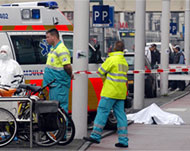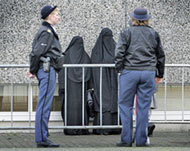Is the Netherlands moving to the right?
The publication of derogatory cartoons of Prophet Muhammad has brought attention once again on to the religious and cultural tensions growing in the Netherlands.

After the murder of Theo van Gogh, a libertarian Dutch filmmaker and controversial critic of Islam in 2004, opposition to immigrants rose rapidly in this traditionally tolerant country.
The fact that Van Gogh’s killer was Muslim led to a backlash against the Muslim community.
Van Gogh’s murder was seen by some in Dutch society as an effort by “extremism” to silence freedom of expression.
When Muslims protested, sometimes violently, over the blasphemous cartoons in late January, the existing distrust and negative image of Muslims was only exacerbated.
Multicultural failure?
Both incidents led Dutch pundits to argue that multiculturalism had failed and tolerance, which the Netherlands had prided itself on, had been taken advantage of by an intolerant immigrant population.
 |
|
Theo van Gogh was shot, stabbed |
Roel Storm, a retired teacher in eastern Amsterdam, who attended a ceremony marking the one-year anniversary of Van Gogh’s death last November, believes the integration of immigrants has become nearly impossible.
“Moroccans live with Moroccans, Turks with Turks and other Dutch with other Dutch. They live separately. This is the root of the problem,” Storm said.
“Actually, I think there are too many Turks and Moroccans. It is high time to stop the influx of immigrants now.”
Cartoons
Since a Danish paper printed 12 cartoons of Prophet Muhammad last year, there have been no major demonstrations by Muslims in the Netherlands, unlike elsewhere in the world.
 |
|
Jan Peter Balkenende says he is |
However, that has not prevented some groups from escalating the issue.
Geert Wilders, a right-wing Dutch politician known for his anti-immigration and anti-Islam stance, republished the cartoons on his website, naturally offending many Muslims.
On 9 February, Ayaan Hirsi Ali, who is a Somali-born Dutch politician and was a friend of Van Gogh’s, told the international media that she believes in “the right to offend”.
Jan Peter Balkenende, the Dutch prime minister, meanwhile, said his government was attempting to de-escalate the debate and that Hirsi Ali’s comments were not helping this move.
The Muslim community
??
First generation immigrants constitute about 10% of the Dutch population of 16 million. If second-generation Dutch are included, the immigrant population rises to 19%, which is about three million. Half of them are described as non-Western immigrants.
The Muslim population is currently nearing one million people.
|
“Be afraid of having fear toward your neighbours. We don’t want to divide society” |
The largest group comes from former Dutch colonies, such as Indonesia (about 400,000) and the Surinam Republic (about 320,000). Another big group is formed by those who were invited by the Dutch government to fill a labour shortage – Turkish (350,000) and Moroccans (300,000) – in the 1960s and 1970s.
But participation in the labour market by Moroccan and Turkish immigrants is 10% lower than for the indigenous Dutch. Job applicants who have Arabic-sounding family names are said to be avoided by a lot of employers.
Fear is one factor, despite the catchphrase by Job Cohen, the mayor of Amsterdam: “Be afraid of having fear toward your neighbours. We don’t want to divide society.”
?
According to Bernard Welten, Amsterdam’s police commissioner, following Van Gogh’s murder and the attacks on the London transport system in July last year, the possibility of similar acts “is imminent” and the danger is “growing high”.
Muslim voices
Ali Abd al-Hag, a Pakistani-Dutch Muslim who came to the Netherlands 30 years ago from South Africa, believes there is little empathy for Muslims who are killed.
“People make a fuss after one white Dutchman has been murdered. I [want] to remind people that the Netherlands and other Western nations are killing many Muslims in the world,” he said.
??
“The Dutch do not care how many Muslims are killed.”
Florist Ali Shauket, a Muslim immigrant from Pakistan, has been living in Amsterdam since 1987.
“Situations have changed recently, politics in this nation are moving more and more to the right.”
Immigration tightened
Some of those changes include the government’s tightening of immigration policies and a more aggressive stance regarding cultural assimilation.
In late January, Rita Verdonk, the immigration and integration minister, caused a stir by saying that everyone should speak Dutch in public places.
 |
|
Very few women cover their |
As of 15 March, people from outside the European Union who seek residence in the Netherlands will be required to take a Dutch language test over the telephone.
Among the 14,000 people who are expected to take the test, the majority are those who want to join family members already living in the country.
Dutch ministers are also calling for a partial public ban of the burqa, which they say is “a symbol of repression of women” for security reasons. The burqa is worn in some Muslim countries and covers the body and face.
Only a handful of Muslim women wear the burqa in the Netherlands, but many regard this move as further pressure on Muslims in general.
Building consensus
Yassin Hartog, an integration consultant based in Amsterdam, says the Dutch “polder model” – the Netherlands’ tradition of running a society on consensus – may help.
“It will take many, many years but as a result of debate after debate among politicians, academics and people from different groups with different values, consensus will be eventually reached. Then people can decide what they agree on to live in a civilised society.”
Hartog believes that both sides – the Muslim population and the indigenous Dutch – should understand their respective cultures more and come closer to each other.
“The cartoon incident could become an opportunity for this step,” he said.